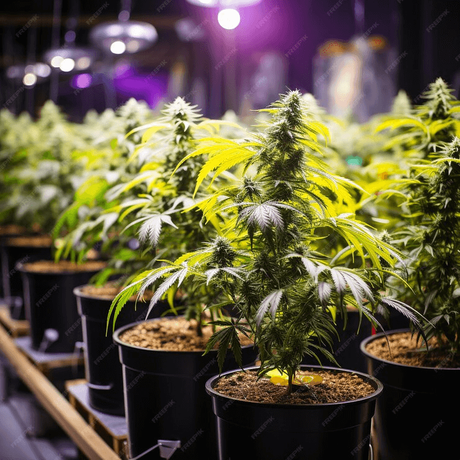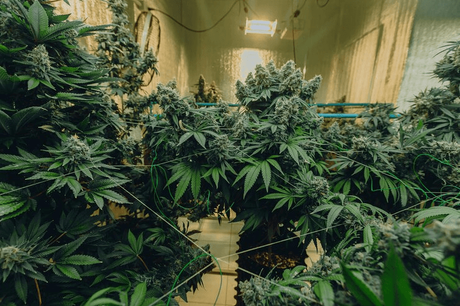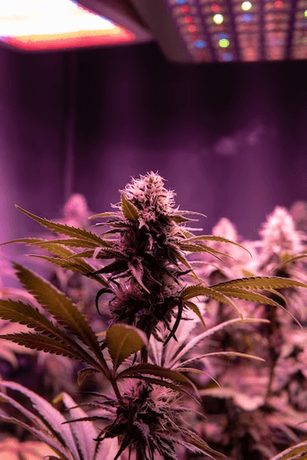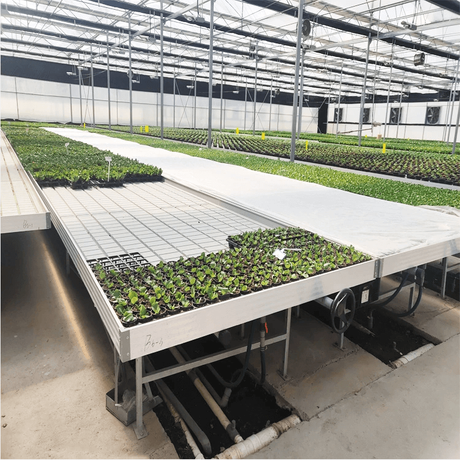Cannabis cultivation within a controlled environment, often referred to as a "flower house," demands precision, dedication, and a comprehensive approach to achieve optimal yield. Whether you're a commercial cultivator aiming for maximum productivity or a home grower seeking abundant harvests, there are numerous strategies and techniques to explore. In this article, we'll delve into a range of factors—from environmental controls to genetics and cultivation practices—that can significantly impact cannabis flower yield.
Why Flower House is Important?
The flowering stage is the most crucial phase in the cannabis plant's life cycle, representing the culmination of vegetative growth and the onset of bud development. It's during this stage that the plant undergoes significant physiological changes, shifting its focus from foliage production to flower formation. As such, the flower room becomes the heart of the operation, where the magic of cannabis cultivation truly happens.
The primary goal of any cannabis cultivation facility is to produce high-quality, high-yielding flower buds. The flower room is where growers devote meticulous attention to optimizing environmental conditions, nutrient management, and cultivation techniques to maximize both quality and quantity of the harvest. The success of the entire operation hinges on the performance of the flower room.
The flowering stage typically requires more resources, including energy, water, nutrients, and labor, compared to the vegetative phase. Therefore, the flower room represents a significant investment of resources and effort within the cannabis facility. It's where growers allocate substantial resources to ensure the plants receive everything they need to thrive and produce a bountiful harvest.
In many regions where cannabis cultivation is legal, strict regulations govern the production and sale of cannabis products. The flower room is subject to rigorous quality control measures and compliance standards to ensure that the final product meets regulatory requirements. It's where meticulous record-keeping, testing, and monitoring procedures are carried out to guarantee product safety, potency, and consistency.
Cannabis cultivation often holds cultural and spiritual significance for enthusiasts and cultivators alike. The flower room embodies this connection to the plant and its transformative journey from seed to harvest. It's a place of reverence and dedication, where growers pour their passion and expertise into nurturing the plants to their fullest potential.
Flower room is rightly regarded as the soul of the indoor cannabis facility because it represents the heart and essence of cannabis cultivation. It's where growers channel their expertise, resources, and passion to produce high-quality flower buds, ensuring the success and vitality of the entire operation.
Understanding Different Cannabis Strains: Experiences and Unique Flowering Characteristics
Cannabis cultivation enthusiasts and growers alike understand the importance of recognizing the distinct genetic traits and growth habits inherent in various cannabis strains. One of the most pivotal stages in the growth cycle of cannabis plants is the flowering stage, where each strain may exhibit unique characteristics and behaviors. Let's explore some common cannabis strains and their flowering traits:
Indica Strains:
Flowering Time: Indica strains typically enter the flowering stage early in the growth cycle, usually around 6-8 weeks.
Flower Structure: Indica strains tend to have short, dense flower clusters resembling cones, often displaying thick stigmas and resin glands.
Growth Habits: Indica strains usually have a shorter stature with wide leaves and dense branching. They tend to produce more lateral branches and top buds during flowering.
Sativa Strains:
Flowering Time: Sativa strains typically enter the flowering stage later in the growth cycle, usually around 10-14 weeks.
Flower Structure: Sativa strains typically have long, loose flower clusters resembling cones or cylinders, with fewer but longer stigmas and resin glands.
Growth Habits: Sativa strains generally have taller growth with narrow leaves and fewer branches. They tend to produce more top buds and fewer lateral branches during flowering.
Hybrid Strains:
Flowering Time: Hybrid strains' flowering time can vary depending on their genetic makeup and specific strain, typically falling somewhere between Indica and Sativa.
Flower Structure: Hybrid strains may exhibit a range of flower characteristics, combining traits from both Indica and Sativa.
Growth Habits: Hybrid strains may display a mix of Indica and Sativa characteristics in terms of growth form and habits, varying from strain to strain.
Autoflowering Strains:
Flowering Time: Autoflowering strains are not influenced by light cycles and typically enter the flowering stage around 3-4 weeks into the growth cycle.
Flower Structure: Autoflowering strains may have smaller and shorter flower clusters, often with a dwarfed growth form.
Growth Habits: Autoflowering strains have a shorter growth cycle, usually completing the entire growth cycle within 8-10 weeks, making them suitable for growers seeking quick harvests.
How to Increase Yield in a Cannabis Flower House
Environmental Control and Optimization
Temperature and Humidity Management: Maintaining stable temperature and humidity levels is crucial for cannabis cultivation. Aim for temperatures between 70-85°F (21-29°C) during the day and slightly cooler temperatures at night. Humidity levels should typically range between 40-60% during vegetative growth and 40-50% during flowering to prevent mold and mildew.
Lighting: High-quality lighting is essential for robust cannabis flower development. Consider using full-spectrum LED grow lights, which mimic natural sunlight and provide the necessary wavelengths for optimal growth and flowering. Ensure proper light intensity, duration, and distribution throughout the canopy to maximize photosynthesis and bud production.
Air Circulation and Ventilation: Adequate airflow within the flower house is crucial for preventing pests, diseases, and mold while promoting strong, healthy plant growth. Install fans and ventilation systems to maintain consistent air circulation and exchange, ensuring plants receive fresh CO2 and oxygen.
Nutrient Management
Soil Quality and Fertilization: Start with high-quality, well-draining soil or a hydroponic system tailored to cannabis cultivation. Monitor soil pH levels and nutrient concentrations regularly, adjusting fertilization schedules accordingly. Consider using organic fertilizers or a balanced nutrient solution formulated specifically for cannabis during different growth stages.
Watering: Implement an efficient irrigation system such as drip irrigation or a hydroponic setup to deliver water and nutrients directly to the root zone. Avoid overwatering, as it can lead to root rot and other issues. Monitor soil moisture levels and adjust watering frequency based on plant needs and environmental conditions.
Genetics and Strain Selection
Choose High-Yielding Strains: Select cannabis strains known for their high yield potential, potency, and suitability to your growing environment. Consider factors such as flowering time, cannabinoid profile, and growth characteristics when choosing strains for cultivation.
Clone Propagation: Cloning high-performing mother plants allows for consistent yields and quality across multiple harvests. Invest in a cloning setup to propagate genetically identical clones with desirable traits, ensuring uniformity and predictability in your flower house.
Training and Pruning Techniques
Topping and FIMming: Topping involves removing the apical meristem of the main stem to encourage lateral growth and multiple bud sites. FIMming (short for "Fuck, I missed") is a similar technique that involves removing a portion of the new growth tips to achieve similar results. These techniques promote bushier, more productive plants with increased flower sites.
LST (Low-Stress Training): LST involves gently bending and securing branches to encourage horizontal growth and light penetration throughout the canopy. By training plants to grow laterally rather than vertically, LST maximizes the number of bud sites exposed to light, resulting in higher yields and more uniform canopy coverage.
Defoliation: Strategic defoliation involves selectively removing fan leaves and lower foliage to improve airflow, light penetration, and bud development. While excessive defoliation can stress plants, moderate pruning of shaded or overcrowded areas can enhance overall yield and quality.
Pest and Disease Management
Preventative Measures: Implement integrated pest management (IPM) strategies to minimize the risk of pests and diseases. Regularly inspect plants for signs of infestation and take proactive measures such as introducing beneficial insects or using organic pesticides when necessary.
Sanitation: Maintain cleanliness in the flower house to prevent the buildup of pests and pathogens. Regularly sanitize equipment, tools, and growing containers to minimize the risk of contamination and ensure a healthy growing environment for your cannabis plants.
Harvesting and Post-Harvest Care
Timing: Harvest cannabis flowers at the peak of their cannabinoid and terpene content for optimal potency and flavor. Monitor trichome development using a magnifying loupe or microscope and harvest when trichomes are milky white with some amber hues for a balanced high.
Drying and Curing: Proper drying and curing are essential for preserving the quality, aroma, and potency of harvested cannabis flowers. Hang harvested buds in a dark, well-ventilated space with moderate humidity levels (around 50%) for 7-14 days, then transfer to airtight containers for curing. Burp containers regularly to release excess moisture and promote a slow, even cure, resulting in smooth-smoking, flavorful buds.
Continuous Monitoring and Adaptation
Data Collection: Keep detailed records of environmental conditions, nutrient inputs, and plant growth patterns to identify trends and optimize cultivation practices over time. Use digital sensors and monitoring systems to track key metrics such as temperature, humidity, CO2 levels, and pH, allowing for precise adjustments and fine-tuning of growing parameters.
Adaptive Management: Remain flexible and responsive to changes in your flower house environment and plant health. Monitor plant vigor, growth rates, and overall health, adjusting cultivation practices as needed to optimize yield, quality, and efficiency.
Achieving maximum cannabis flower yield in your flower house requires a holistic approach that addresses environmental, genetic, and management factors. By optimizing growing conditions, selecting high-performing strains, implementing effective cultivation techniques, and continuously monitoring and adapting your approach, you can cultivate abundant, high-quality cannabis flowers year-round. With dedication, experimentation, and a commitment to excellence, you can unlock the full potential of your flower house and enjoy bountiful harvests of premium cannabis buds.
 English
English








